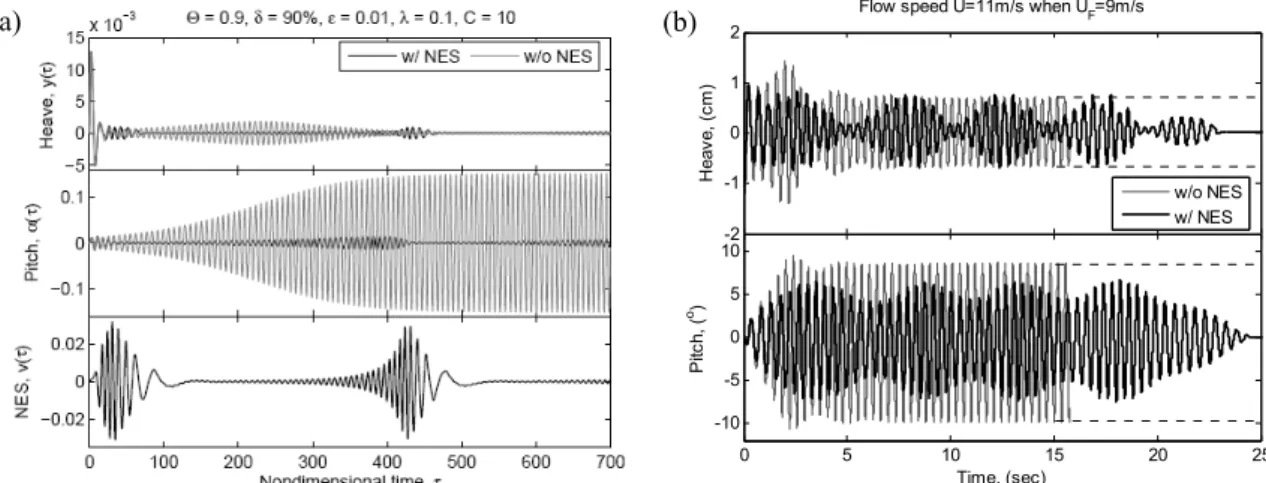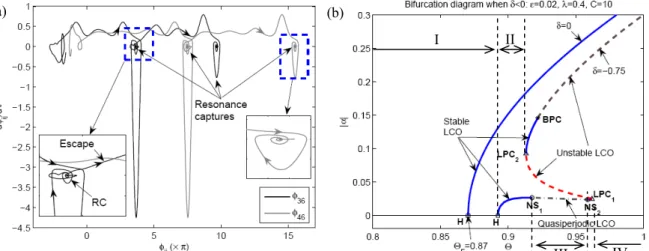TARGETED ENERGY TRANSFERS AND SUPPRESSION
OF AEROELASTIC INSTABILITIES
Young S. Lee (1), Alexander F. Vakakis (2), Lawrence A. Bergman (1), D. Michael McFarland (1), Gaëtan Kerschen (3)
(1) University of Illinois at Urbana-Champaign,
yslee4@uiuc.edu; lbergman@uiuc.edu; dmmcf@uiuc.edu
(2) National Technical University of Athens, vakakis@central.ntua.gr
(3) Université de Liège, g.kerschen@ulg.ac.be
EXTENDED ABSTRACT
Passive and nonlinear targeted energy transfers induced by resonant interactions between a single-degree-of-freedom (DOF) essentially nonlinear energy sink (NES) and a two-DOF in-flow rigid wing model are studied (Fig. 1 (a)). It is shown that it is feasible to partially or even completely suppress aeroelastic instabilities in the wing (limit cycle oscillations - LCOs) by passively transferring vibration energy from the wing to the NES in a one-way irreversible fashion. Moreover, this aeroelastic instability suppression is performed by partially or completely eliminating the triggering mechanism for aeroelastic suppression as discussed in Lee et al. [1].
Through numerical parametric studies, three main mechanisms for suppressing aeroelastic instability are identified: (i) Recurring burst-out-and-suppression (e.g., Fig. 2 (a)); (ii) intermediate suppression; and (iii) complete elimination. These mechanisms are investigated in detail, both numerically by the Hilbert-Huang transform and analytically by a two-frequency complexification-averaging technique (Fig. 3 (a)). Each suppression mechanism involves strong one-to-one resonance capture during which the NES absorbs and dissipates a significant portion of energy fed from the flow to the wing. Failure of suppression is associated with a series of superharmonic resonance captures followed by escapes from resonance. This is similar to the underlying LCO triggering mechanism as discussed by Lee et al. [1], which further underlines the importance of suppressing the LCO triggering mechanism for effective aeroelastic instability suppression.
In addition, sensitive dependence on initial conditions and robustness of LCO suppression through a steady-state bifurcation analysis utilizing numerical continuation of bifurcation points of equilibria and limit cycles are studied. For example, Fig. 3 (b) depicts that, with an NES attached to a wing at the 75% of the semi-chord toward the wing nose from the elastic axis, complete and robust elimination of aeroelastic instabilities can be achieved in region I; robust intermediate suppression, in region II; and recurring bursts-out and suppressions, in region III. For the flow speeds in region IV, no aeroelastic instability suppression is ever possible.
This bifurcation analysis provides design criteria for an NES, as well as why and how those three suppression mechanisms can be observed. First, application of a single NES with nonzero offset attachment can delay the occurrence of LCOs (second suppression mechanism) generated at a Hopf bifurcation point, involving complete elimination of aeroelastic instabilities (third suppression mechanism); Robutsness of suppression depends on the existence of subcritical LCOs. Recurring burst-out-and-suppressions observed in the first suppression mechanism is due to the Neimark-Sacker (NS) bifurcation which gives birth to another periodic motion and thus quasiperiodic LCOs in total. Therefore, occurrence of these recurring burst-out-and-suppression is a precursor to non-robust suppression or even no suppression.
Furthermore, suppression of aeroelastic instabilities is experimetnally verified by utilizing the NES equipment at the University of Illinois at Urbana-Champaign combined with the NATA (Nonlinear Aeroelastic Test Apparatus) at Texas A&M University [2]. Not only are all the theoretically predicted behaviors observed, but also additional suppression effects are provided by the Coulomb friction present in the NATA. For example, the beating-like responses of the in-flow wing in Fig. 2 (b) become smaller and stuck to an static equilibrium position at the steady state.
ACKNOWLEDGMENTS
This work was supported by the US Air Force Office of Scientific Research through Grant Number FA9550-04-1-0073. GK would like to acknowledge support from the Belgian National Fund for Scientific Research (FNRS), which made his visit to the University of Illinois possible.
REFERENCES
[1] Y.S. Lee, A.F. Vakakis, L.A. Bergman, D.M. McFarland, and Gaetan Kerschen, ‘Triggering Mechanisms of Limit Cycle Oscillations in a Two-Degree-of-Freedom Wing Flutter Model,’ Journal of
Fluids and Structures, 21, 485-529, 2005.
[2] T. O’Neil, H. Gilliatt, and T. Strganac, ‘Investigations of Aeroelastic Response for a System with Continuous Structural Nonlinearities,’ 37th AIAA Structures, Structural Dynamics and Materials
Conference, AIAA Paper 96-1390, 1996.
FIGURES
Figure 1: (a) Two-dof in-flow wing model coupled with a single-dof NES; (b) NATA equipped with an NES.
-2 -1 0 1 2 H eav e, ( cm )
Flow speed U=11m/s when UF=9m/s
w/o NES w/ NES 0 5 10 15 20 25 -10 -5 0 5 10 Time, (sec) P itc h, ( o)
Figure 2: The first LCO suppression mechanism consisting of recurring burst-out and suppression: (a) Numerical simulation; (b) experimental observation with a 10% mass ratio and zero offset attachment.
Flow Wing NES NES Wing (a) (b) (a) (b)
Figure 3: (a) Recurring resonance captures and escapes from resonance for the first suppression mechanism in the phase plane; (b) bifurcation diagrams of the steady-state pitch amplitudes with respect to the flow speed for
fixed mass ratio, damping, and essential nonlinearity and for two differernt offset attachments.
I II
III IV

